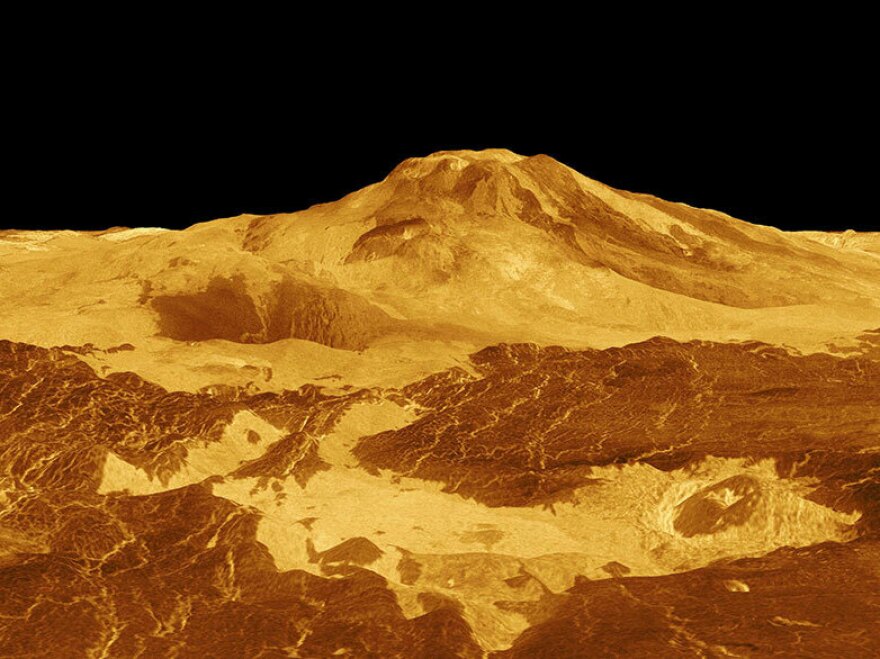Researchers scouring decades-old spacecraft data have found clear signs of recent volcanic activity on Venus. The findings, published in the journal Science, reveal not only that the planet's surface is currently a turbulent place, but offer insights into its geological past and future.
By any measure, Venus is a hellscape: crushing pressures, a toxic atmosphere, and surface temperatures hot enough to melt lead. It's like a scene lifted straight from Dante's Inferno.
It's "my favorite planet," says Robert Herrick, a planetary scientist at the University of Alaska Fairbanks.
Despite all its hostility, Venus — our nearest planetary neighbor — is actually pretty similar to Earth. So much so that Herrick calls it our "true sibling" in the solar system. The resemblance is "driven by what's going on in their interior," he says.
"Aside from Earth," Herrick says, "it's the only planet that has true mountain ranges and a huge variety of volcanic features." These features include lava fields, canals carved by molten rock, and hundreds, if not thousands of volcanoes.
So it's clear that Venus is volcanically active, giving it a youthful (in geological terms) appearance. But it's not clear exactly how active.
"That could still mean that the time between eruptions could be months, years, or tens of thousands of years," says Herrick.
So he set out to try to narrow down that time window by searching for evidence of recent volcanic activity. He turned to radar surface imagery collected by the Magellan spacecraft in the early 1990's.
"Thirty years ago," he says, "it was just not feasible to pan around and zoom in and out and flip back and forth between different global mosaics." But computer hardware and software have improved substantially, and so Herrick was able to pore over the imagery.
"It's a needle in a haystack search without any guarantee that there's a needle," he admits.
Herrick focused his search around the highest volcano on Venus called Maat Mons, named after the ancient Egyptian goddess of truth and justice. And after a couple months of looking across an area about the size of Australia, he found something.
It's evident in two side-by-side black-and-white images taken eight months apart of the same spot on the north side of the volcano. Each one is about 15 or 20 miles across. Herrick points out a pockmark towards the bottom. It's a vent — the area where a volcano erupts, discharging its lava, ash, and rock. But the shape of that vent differs between the two images.
"The outline has changed, and the thing's actually gotten larger, and looks shallower as well," he says. That is, within a mere eight months in 1991 (the same year that President George H. W. Bush declared victory over Iraq and Clarence Thomas was confirmed as a Supreme Court Justice), Herrick speculates the volcano erupted, forming a lava lake within the vent.
"Of course, I could have gotten very lucky and seen the only thing that happened in the last million years on Venus," Herrick says. "But I think the reasonable interpretation suggests that Venus is relatively Earth-like in the frequency of volcanic eruptions," similar to the likes of Hawaii and Iceland.
Unlike Earth, Venus doesn't have plate tectonics. So researchers have been trying to work out how the planet has evolved geologically over the last four-and-a-half billion years and where it might be headed. Herrick and his colleague Scott Hensley hope their findings will help do just that.
"It is nice to have a visual confirmation of the volcanic activity on Venus," says Clara Sousa-Silva, a quantum astrochemist at Bard College who wasn't involved in the research. "But given that this was something we had speculated, it's not shocking to have this paper come out."
Still, Sousa-Silva says this confirmation of activity on Venus's surface does help us better understand what to expect in Venus' atmosphere.
"A planet that has a lot of volcanic activity," she says, "has access to these extreme pressures and temperatures below the surface that can produce molecules that are really unusual and otherwise really hard to make."
Much of NASA's (and the public's) recent attention has been drawn to Mars; the space agency has landed five rovers on the Red Planet's dusty surface since 1997.
But Herrick says that Earth's similarity to Mars is somewhat superficial, being pretty much limited to surface features like sand blowing around, desert landscapes, and signs of what may have once been lakes and rivers.
The winds of interest have shifted, though. "Maybe it's cycling back like bell bottoms," Herrick says with a chuckle.
That's because NASA currently has two missions to Venus in the works, which will now be informed by Herrick's findings. "We don't just think it's an active planet," he says. "We know it's an active planet — right now."
Herrick is working with NASA to develop an instrument for those upcoming missions to monitor volcanic activity on Venus. He's pretty confident now that the seismometer will register something once it's deployed — as long as it can survive the infernal planet long enough to make its measurements.
Copyright 2023 NPR. To see more, visit https://www.npr.org.






